23 Jul Why Prioritizing SEO Should Be Part of Every SVOD Provider’s Roadmap via @lefelstein
Steady growth is predicted for Subscription Video on Demand (SVOD) services over the next few years as consumers turn their sights, and wallets, to streaming services.
For SVOD providers (such as Netflix, Hulu, etc.), this increase in consumer demand means more opportunities to capture the attention of their target audiences with an important caveat – content must be easily discoverable.
“Content discoverability” refers to the ease of which consumers can hear about and find streamable content.
It’s cited as one of the major sticking points for consumers who frequently sit down to watch TV without a specific show or movie in mind.
This fact, paired with an increasingly saturated market of streaming service providers and content libraries, illustrates the importance for SVOD product marketing teams to prioritize content discovery on their 2020-2021 roadmap.
While there are many “marketing pieces” that connect within the”content discoverability puzzle”, search engine optimization is a key piece that mustn’t be ignored by product marketing teams.
Throughout the remainder of this post, I’ll walk you through:
- The consumer demand for SVOD services.
- The high stakes surrounding content discoverability and SEO.
- Three tips for getting SVOD content discovered in Google.
The Demand for SVOD Services in 2020 & Beyond
The SVOD industry is predicted to grow consistently over the next few years in the areas of users, revenue, and time spent streaming.
And the Coronavirus pandemic played a big factor in the rising demand.
More details below.
User + Revenue Growth By the Millions
A June 2020 research study from Statista predicted that:
- U.S. SVOD users would increase from 127.5 million in 2020 to 135.5 million by 2024 (a +5% increase).
- SVOD revenue would increase from 12.5 million in 2020 to 13.6 million by 2024 (a +9% increase).
In total, the study predicted an 8-year percentage growth for SVOD users from 2017-2024 to be 16%, and for revenue is +45%.




A study conducted by eMarketer in February 2020 had user growth findings similar to Statista.
It predicted that the entire OTT industry (the overarching umbrella that SVOD falls under), would grow from 221.9 million U.S. users in 2020 to 236.2 million in 2024 (a +6% increase).
It also anticipated that by 2024, nearly 70% of the U.S. population would use an OTT video service.


Unsurprisingly, this data affirms that as more of the population begins using OTT video services the opportunity for providers to generate revenue also increases.
Users Are Spending (Way) More Time Inside of Streaming Apps
Along with the OTT/SVOD industry’s increase in overall users and revenue, comes an increase in the average number of hours spent by U.S. consumers actually streaming content.
A February 2019 research study from Deloitte found that U.S. internet users spend 6.1 hours per week (52 minutes a day) on average watching SVOD content.


A September 2019 PCMag informal poll saw even larger numbers.
Of the 1,001 U.S. adults polled:
- 52% of participants spent 10 hours a week (1.42 hours/day) on streaming services.
- 24% of participants spent 20 hours a week (2.85 hours/day).
- 10% of participants spent 30 hours a week (4.28 hours/day).
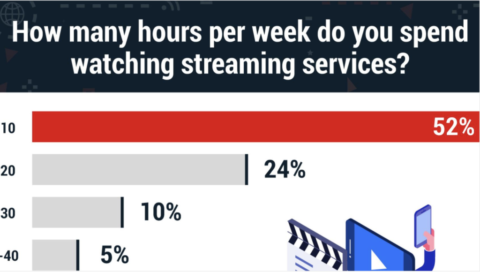

While these two studies don’t line up perfectly, they seem to agree that U.S. consumers are spending hours per week streaming SVOD content – ranging from the equivalent of one full workday (~8 hours) streaming to one full work week (~40 hours) streaming.
Coronavirus Leads Consumers to Subscribe to More SVOD Services
The stay-at-home policies enforced due to the pandemic have contributed to a spike in SVOD subscriptions in the U.S.
A study conducted by Integral Ad Science of 1,072 U.S. adults indicated:
- 27% of participants in the age group of 18-29 subscribed to a paid SVOD service due to the Coronavirus pandemic.
- 47% of this age group subscribed to a free SVOD service due to the pandemic.
The same study found that:
- 24% of U.S. adults in the age group of 30-44 subscribed to a paid SVOD service directly due to pandemic.
- 52% of this age group subscribed to a free SVOD service due to the pandemic.


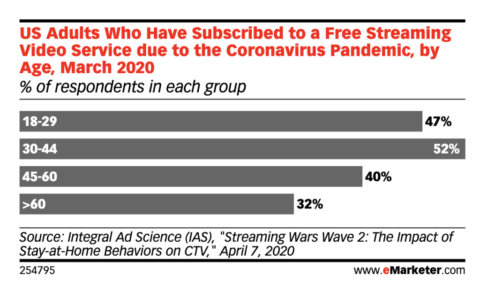

Another study reported that 21% of U.S. adults listed the pandemic as either a minor or major reason for subscribing to a new streaming service.
There’s been a general 4% increase in the number of SVOD services U.S. adults have from Q4 2019 to Q2 2020, as well as a 3% decline in U.S. adults with no SVOD subscriptions.
To win the streaming wars, SVOD providers need to get competitive.
Having great content isn’t enough – it must be discoverable too.
In the coming section, we’ll review the importance – and current challenges – in getting content discovered by consumers.
Importance of Content Discoverability
As SVOD content libraries continue to grow, prioritizing discovery becomes increasingly important to maintaining an edge in the market.
Research suggests that there’s still plenty of room for improvement to make it easier/less frustrating for consumers to find their next show or movie.
For example, a research study conducted by Nielsen last year found that most U.S. adults frequently don’t know exactly what they want to watch prior to sitting down. It found that:
- ~22% of the time U.S. Adults ‘don’t know what they want to watch at all prior to watching’ – peaking at the 18-34 year old demographic at 30%
- ~33% of the time U.S. Adults ‘have a rough idea, but don’t know exactly what they want to watch’ – peaking at the 18-34 year old demographic at 40%
- ~66% of the time U.S. Adults ‘know exactly what they want to watch’ – peaking at the 65+ years old category at 70%
A quote from the study:
“As more and more streaming platforms compete for users’ time, operators are struggling to differentiate their offerings, crack the content discovery code and keep consumers tuned in.” – Nielsen
A similar research study from PriceWaterhouseCoopers (PWC) in 2017 found that:
- At least half of TV consumers (55%) found themselves looking for a new TV show or movie to watch at least once per week, and 84% did a few times per month.
- Of this group, two-thirds (62%) of consumers agreed that they “often” struggle to find something to watch – despite there being many choices available to them.
A quote from the study:
“Flooded by options from an ever-growing library of video content, consumers are struggling to find what they want. Add in a rapidly growing, fragmented marketplace of distribution platforms, and we’re left with a consumer that’s overwhelmed, and ‘A’ content that’s left undiscovered and unwatched.”
How SEO Can Help
While there are many ways that a company can improve their content discoverability – such as improving in-app search functionality, airing commercials, and promoting via social media platforms – my area of focus is on how SVOD providers can improve their website’s discovery via traditional search engines like Google.
But before I share my three tips, let’s review why it’s so valuable in the first place.
What the Research Says
Consumers frequently use online browsing / search engines to get recommendations on what to watch on TV.
This means prioritizing your website to show up well in search can greatly influence content discoverability.
But just how frequently are we talking about?
A 2017 study conducted by the Interactive Advertising Bureau (IAB) found that online browsing makes up as much as 36% of the top ways users hear about and find subscription service original shows.


Without proper SEO, streaming services are missing out on this piece of the discovery puzzle.
Reviewing the Data with a Monthly Search Volume Lens
There are 3.5 million searches for the query, “what to watch” every month on Google.
The last six months in particular have seen even higher numbers, with “what to watch” hitting a whopping 6.1 million searches in June.
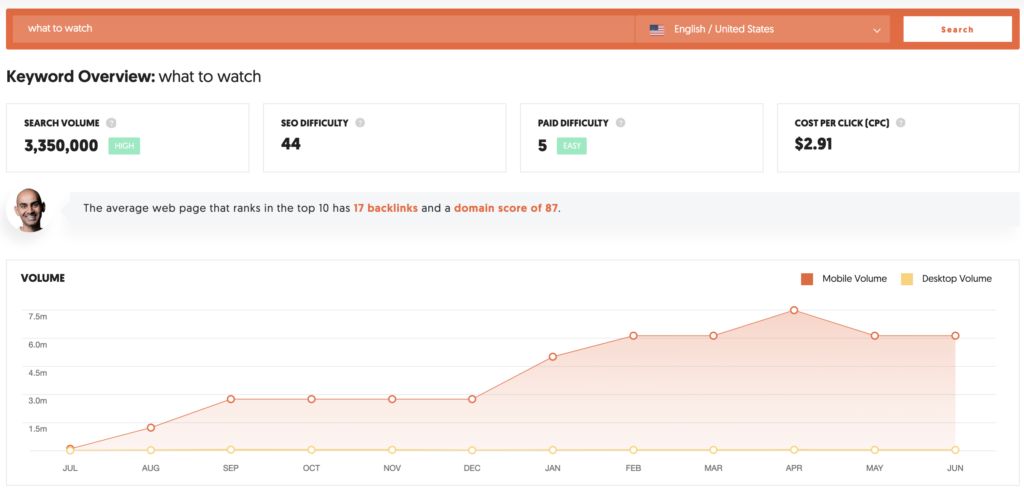
 Keyword data via UberSuggest, July 2020
Keyword data via UberSuggest, July 2020Queries like “What to watch on [platform]” and “best [genre] movies” also have impressive monthly search volumes (MSV).
A few highlighted examples:
- “What to watch on Netflix” = 110K MSV
- “best comedy movies” = 74K MSV
- “Best action movies” = 49.5K MSV
- “What to watch on Hulu” = 18.1K MSV
- “What to watch on HBO” = 5.4K MSV
The takeaway here is that the monthly search volume and user intent indicate that Google search engine results pages (SERPs) are a great place to invest marketing resources.
This fact is not lost on Netflix – who ranks on page 1 for the queries
3 Tips for Making Your SVOD Website Stand Out on Google SERPs
And finally, for the good stuff.
Read on for my top three tips to help your SVOD website perform better in organic search.
1. Add Useful Categories for Users to Browse Your Content
A basic SEO principle is that you can’t rank for something that you don’t have a landing page for.
For SVOD providers, this means that if you want to make it easier for consumers to discover various types of content, it’s necessary to have landing pages dedicated to them.
I’ve found that there are three, equally effective categorization types that can be used to help drive traffic:
- Genres/sub-genres.
- Interests.
- Current events/civil rights issues.
Because Netflix is doing this well, I’ve included their examples under each type below.
I also included some quick SEO statistics*, to help illustrate the value of a strong categorization strategy.
Genre Categories (Comedy, Action, Romance, Etc.)


- Keyword Rankings: 18.6K
- Backlinks: 1.93K
- Estimated monthly traffic: 75.7K
Interest Categories (Such as Martial Arts, Cars, Dancing, Etc.)


- Keyword Rankings: 9.2K
- Backlinks: 1.35K
- Estimated monthly traffic: 6.0K
Current Events / Civil Rights (Such as LGBTQ+ Pride, Women’s History Month, Black Lives Matter)


- Keyword Rankings: 2.2K
- Backlinks: 815
- Estimated monthly traffic: 4.1K
This tip goes both ways.
If your website currently has categories that aren’t bringing in much SEO value, they should be cleaned up and replaced with stronger ones.
*All data pulled from Ahrefs
2. Get Mentioned (& Links from) Editorial Websites
Link building on editorial websites is an excellent way to help get your content discovered by consumers while building the overall authority of your website in the process – as inbound links are a direct ranking factor.
For example, if you do a quick search for “best tv shows to stream this summer”, the entire Page 1 search results is from editorial websites like Mashable.com, Elle.com, Cosmopolitan.com, and more.
Not only do these pages have hundreds to thousands of visits every month (according to Ahrefs data), but they also have strong domain authorities – in the +80/100s.
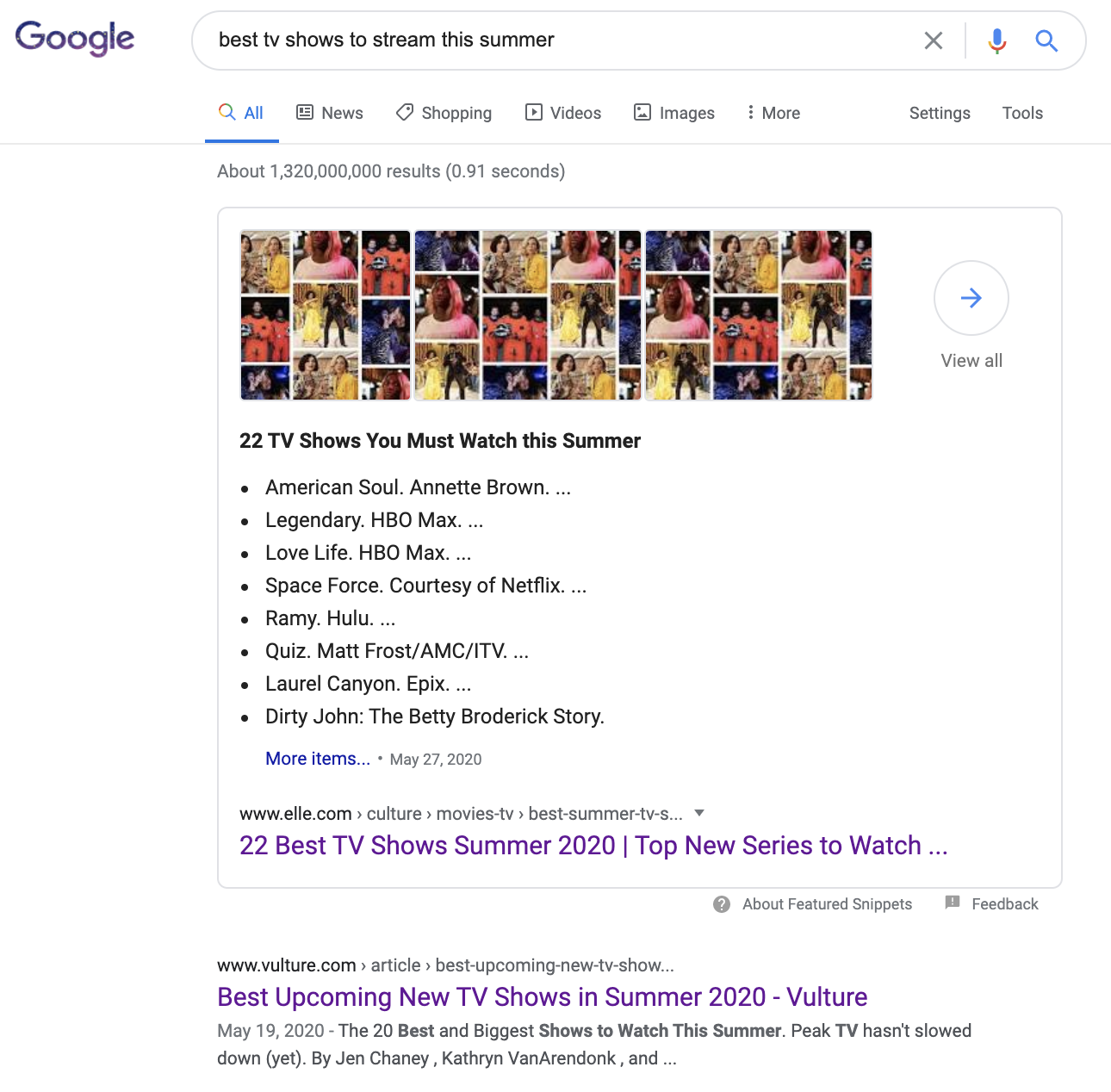

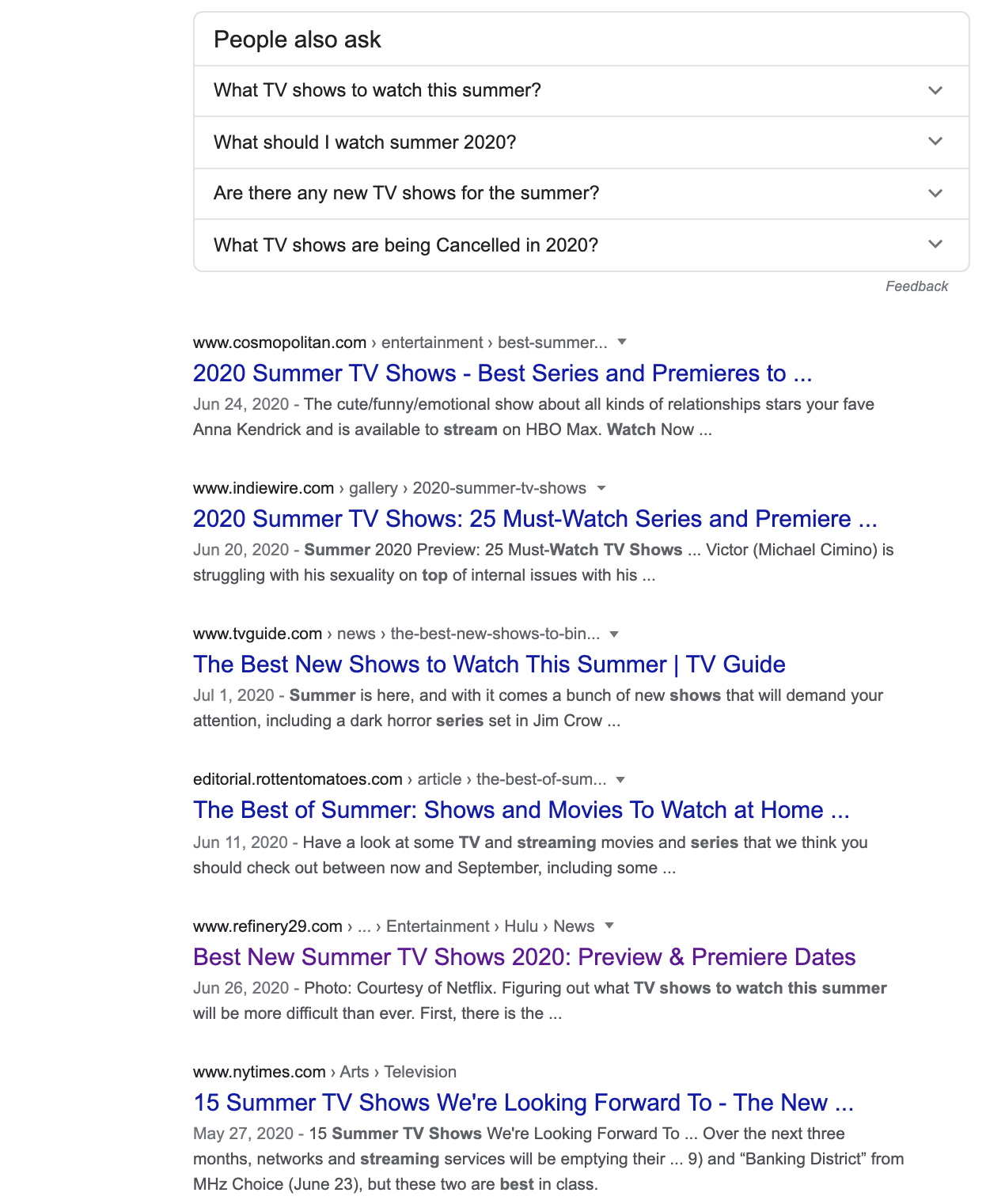

While there is no straight shot strategy for getting backlinks from editorial websites, finding and updating unlinked mentions is a great start.
Product marketing teams can reach out to the authors of articles who mention your service/content, and ask them to update the article with a backlink pointing to your page.
For more instruction on this, I recommend checking out Search Engine Journal’s resource, How to Turn Unlinked Brand Mentions into Links.
3. Use VideoObject, TVSeries & TVSeason Schema
Implementing VideoObject, TVSeries, and TVSeason schema on your website will help search engines understand your content better.
In turn, this schema markup makes your site eligible for attention-grabbing rich results – which can increase CTR.
Here’s an example from HBO’s TV Series page, “Last Week Tonight with John Oliver“:


The page has VideoObject, TVSeries, and TVSeason schema in its source code, which enables the show page to appear better in video rich results. See example below:
Query: “watch last week tonight free online”
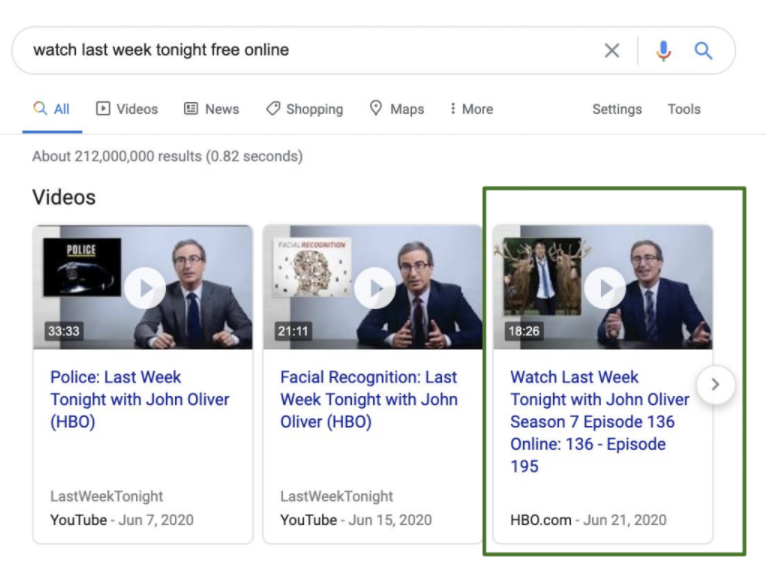

To test if your webpages use these types (or other types) of schema markup, you can use Google tools such as The Structured Data Testing Tool and the Rich Results Test Tool.
To write schema, I love using Technical SEO’s generator tool.
Wrapping Things Up
As the SVOD industry continues to grow, prioritizing SEO should be apart of every product team’s roadmap in order to leverage content discoverability.
Focusing on tactics such as category pages, getting mentioned (and links from) editorial websites, and adding schema markup to relevant pages is a great way to capitalize on the millions of relevant search queries happening on Google every month.
More Resources:
- How to Do SEO for Niche Markets
- 11 Reasons Why You Should Use a Docuseries in Your Content Strategy
- 5 Lessons from Netflix on How to Be Successful with Content Marketing
Image Credits
Featured Image: Adobe Stock
In-Post Images #1-2: Statista
In-Post Image #3: eMarketer
In-Post Image #4: Deloitte / eMarketer
In-Post Image #5: Integral Ad Science / eMarketer
In-Post Image #6: Interactive Advertising Bureau (IAB)
All screenshots taken by author, July 2020
Sorry, the comment form is closed at this time.